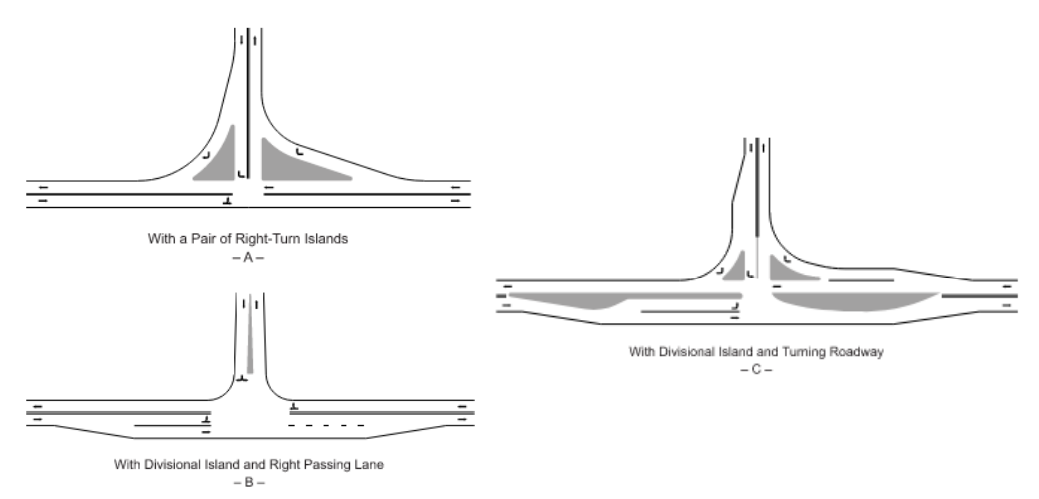13.3.1 Three-Leg Intersection
13.3.1.1 Basic Types
Basic forms of three-leg intersections (i.e., “T-Intersections”) are shown in
and Figure 13-6.
shows the most common type of three-leg intersection. This configuration maintains both roadway widths except for the corner radii where widening is needed to accommodate the turning movements of the selected design vehicle.
This type of unchannelized intersection is usually suitable for junctions of minor or local roads. In rural areas, this type of intersection is commonly used in conjunction with low-volume two-lane highways. In suburban or urban areas, a three-leg intersection may be satisfactory for higher volume two-lane roadways and multilane facilities.

Figure 13-5: Three-leg Intersections
Source: AASHTO’s A Policy on Geometric Design of Highways and Streets
Where speeds or turning movements, or both, are high, additional pavement may be provided for speed-change lanes, as shown in
and
.
However, this type of provision must consider the effects of pedestrian crossing distances.
The use of speed-change lanes (e.g., left- and right-turn lanes) can:
- Reduce crash frequencies;
- Increase intersection capacity;
- Create better operational conditions for turning vehicles;
- Provide a sheltered storage area for turning vehicles; and
- Reduce speed differentials between through and turning traffic.
13.3.1.2 Channelized Three-Leg Intersections
Where channelization is provided, islands and turning roadways should be designed to accommodate the wheel tracks of the design vehicle movement while providing optimum crossing paths and storage for pedestrians within the proposed intersection.
The simplest form of channelization is accomplished by providing a turning roadway that is separated by an island from the normal traveled ways of the intersecting approaches as shown in
and
. The approach roadway may include a separated right-turn lane leading up to the turning roadway to accommodate right-turning traffic. Often the provision for a separated left turn lane or through lane to bypass left-turning traffic is appropriate on two-lane roadways where right-turning roadways are also justified. Left-turning traffic can be accommodated by the flaring of the through roadway as shown in
and
. Right-turning roadways should be designed to discourage wrong-way entry while providing sufficient width for anticipated turning trucks.
Where the traffic demand at an intersection reaches or exceeds the capacity of a two-lane roadway and where signal control may be needed, it may be desirable to convert the two-lane roadway to a divided section through the intersection, as shown in
. In addition to adding auxiliary lanes on the through roadway, the intersecting road (i.e., the stem of the three-leg intersection) may also be widened on one or both sides by providing speed change lanes to increase capacity.
and
provide examples of bypass lanes, which are added to the outside edge of the approach, allowing through vehicles to pass left-turning vehicles on the right, while
and
show traditional left-turn lanes.
Regardless of the treatment,
consideration of traffic demand, delay savings, crash reduction, and construction costs are all key factors in determining whether to install a left-turn lane or a bypass lane.
See
for additional information on bypass lanes.
Figure 13-6: Channelized Three-leg Intersections
Source: AASHTO’s A Policy on Geometric Design of Highways and Streets